A Debate on Misperceptions of Change Management
VerifiedAdded on 2023/06/07
|8
|1698
|161
AI Summary
This article discusses the common misconceptions surrounding change management and how to overcome them. It covers topics such as resistance to change, managing resistance, and the importance of understanding change. The article also provides a brief background on organizational change and how it is managed. Course code, course name, and college/university are not mentioned.
Contribute Materials
Your contribution can guide someone’s learning journey. Share your
documents today.
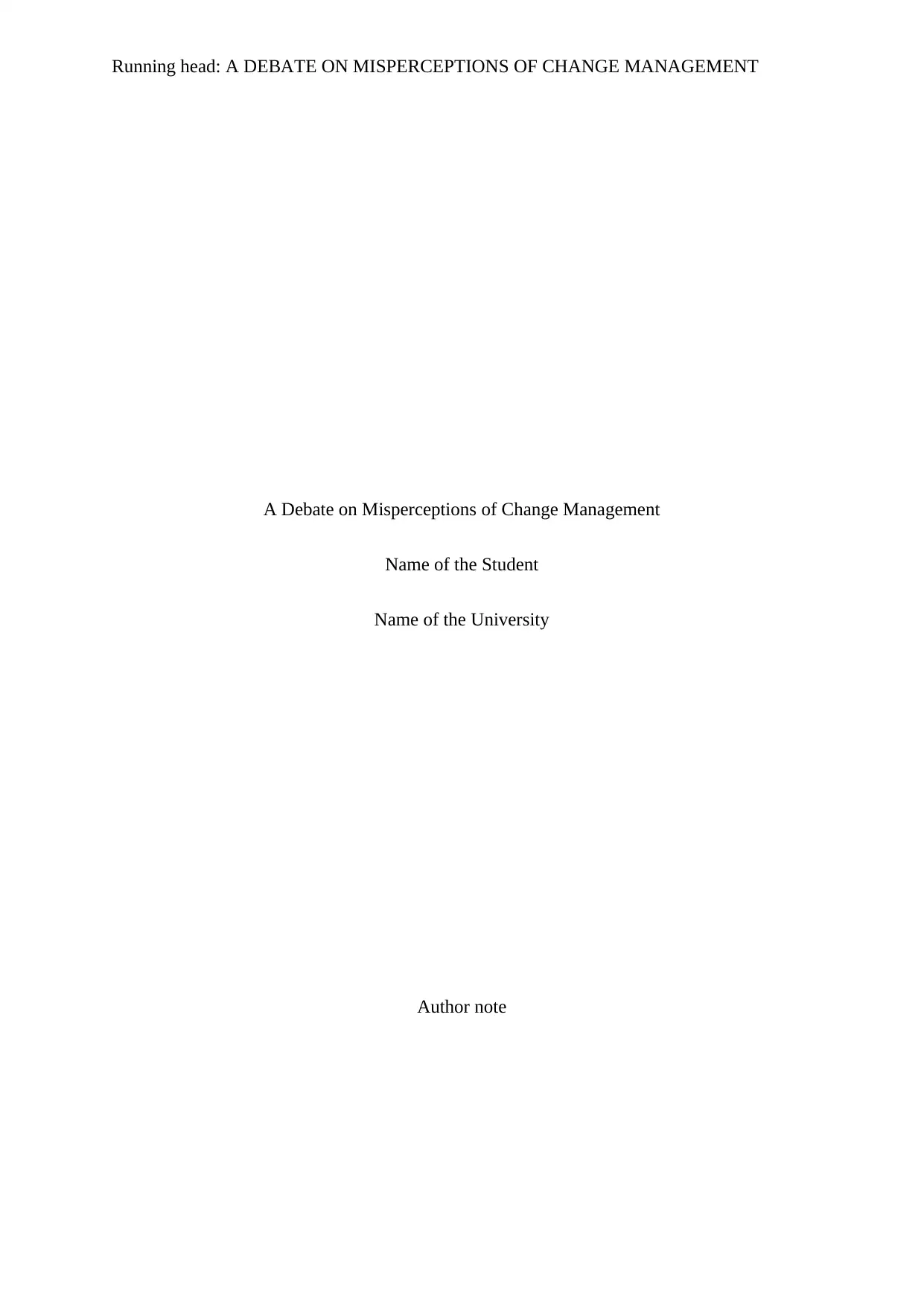
Running head: A DEBATE ON MISPERCEPTIONS OF CHANGE MANAGEMENT
A Debate on Misperceptions of Change Management
Name of the Student
Name of the University
Author note
A Debate on Misperceptions of Change Management
Name of the Student
Name of the University
Author note
Secure Best Marks with AI Grader
Need help grading? Try our AI Grader for instant feedback on your assignments.
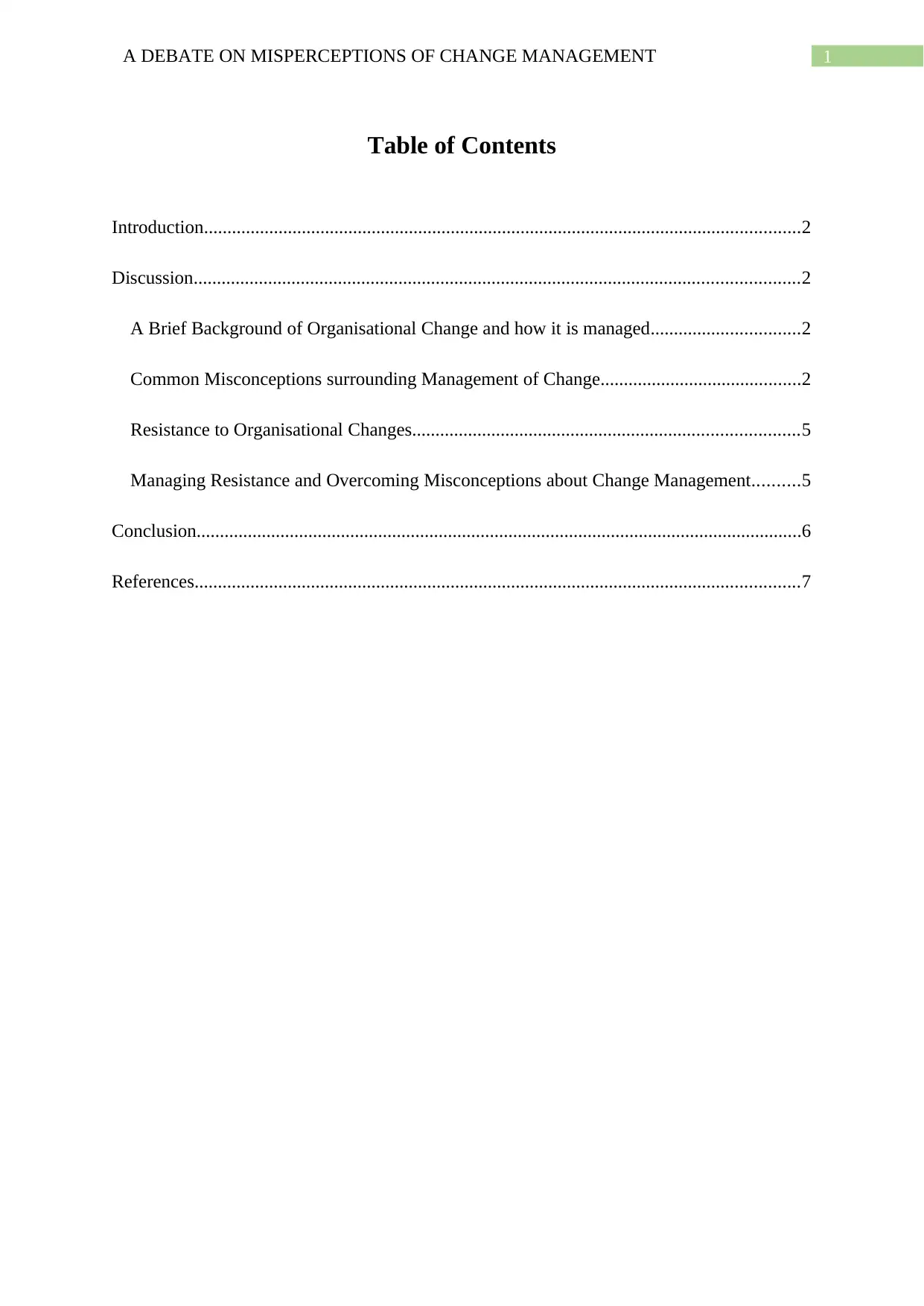
1A DEBATE ON MISPERCEPTIONS OF CHANGE MANAGEMENT
Table of Contents
Introduction................................................................................................................................2
Discussion..................................................................................................................................2
A Brief Background of Organisational Change and how it is managed................................2
Common Misconceptions surrounding Management of Change...........................................2
Resistance to Organisational Changes...................................................................................5
Managing Resistance and Overcoming Misconceptions about Change Management..........5
Conclusion..................................................................................................................................6
References..................................................................................................................................7
Table of Contents
Introduction................................................................................................................................2
Discussion..................................................................................................................................2
A Brief Background of Organisational Change and how it is managed................................2
Common Misconceptions surrounding Management of Change...........................................2
Resistance to Organisational Changes...................................................................................5
Managing Resistance and Overcoming Misconceptions about Change Management..........5
Conclusion..................................................................................................................................6
References..................................................................................................................................7
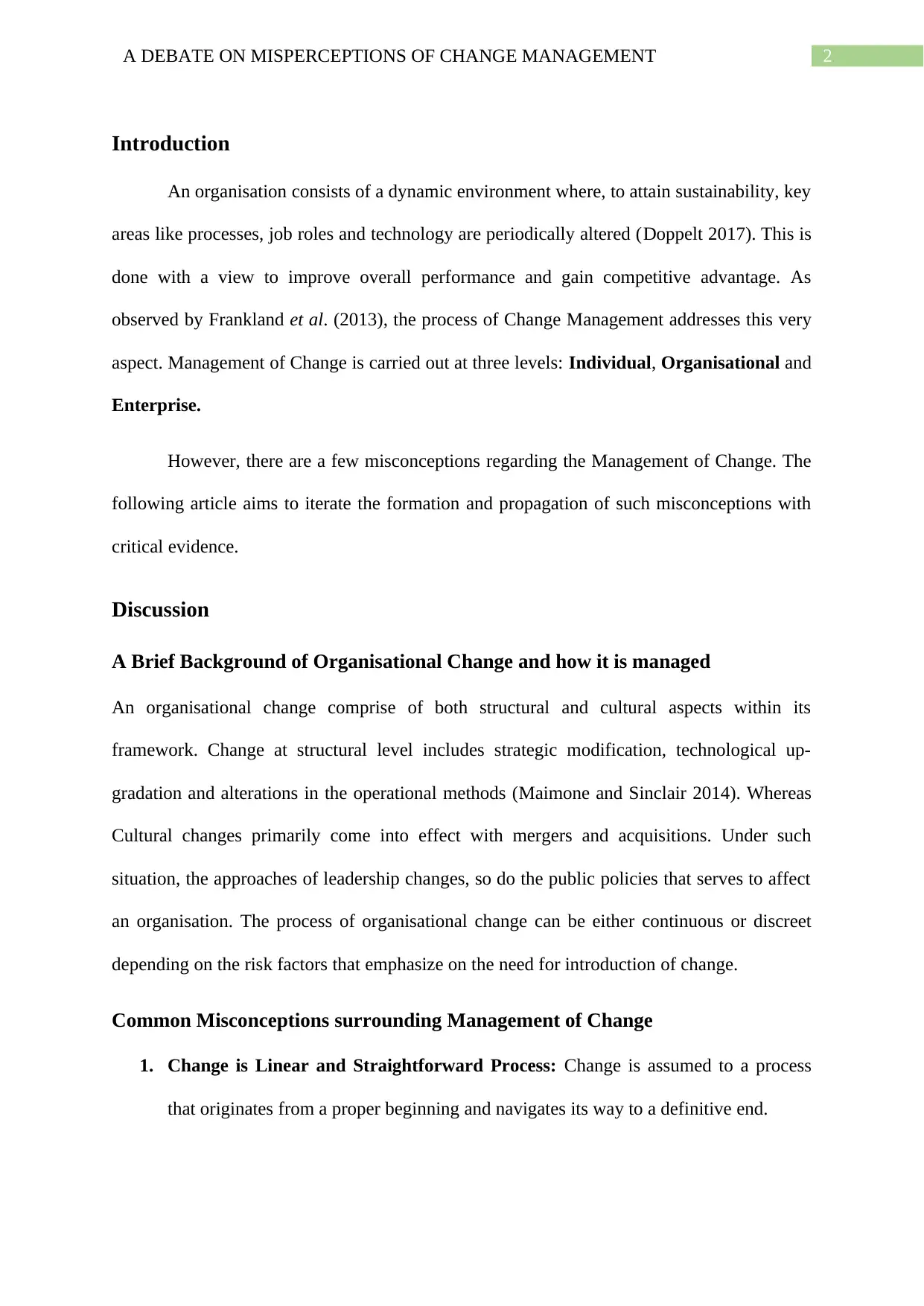
2A DEBATE ON MISPERCEPTIONS OF CHANGE MANAGEMENT
Introduction
An organisation consists of a dynamic environment where, to attain sustainability, key
areas like processes, job roles and technology are periodically altered (Doppelt 2017). This is
done with a view to improve overall performance and gain competitive advantage. As
observed by Frankland et al. (2013), the process of Change Management addresses this very
aspect. Management of Change is carried out at three levels: Individual, Organisational and
Enterprise.
However, there are a few misconceptions regarding the Management of Change. The
following article aims to iterate the formation and propagation of such misconceptions with
critical evidence.
Discussion
A Brief Background of Organisational Change and how it is managed
An organisational change comprise of both structural and cultural aspects within its
framework. Change at structural level includes strategic modification, technological up-
gradation and alterations in the operational methods (Maimone and Sinclair 2014). Whereas
Cultural changes primarily come into effect with mergers and acquisitions. Under such
situation, the approaches of leadership changes, so do the public policies that serves to affect
an organisation. The process of organisational change can be either continuous or discreet
depending on the risk factors that emphasize on the need for introduction of change.
Common Misconceptions surrounding Management of Change
1. Change is Linear and Straightforward Process: Change is assumed to a process
that originates from a proper beginning and navigates its way to a definitive end.
Introduction
An organisation consists of a dynamic environment where, to attain sustainability, key
areas like processes, job roles and technology are periodically altered (Doppelt 2017). This is
done with a view to improve overall performance and gain competitive advantage. As
observed by Frankland et al. (2013), the process of Change Management addresses this very
aspect. Management of Change is carried out at three levels: Individual, Organisational and
Enterprise.
However, there are a few misconceptions regarding the Management of Change. The
following article aims to iterate the formation and propagation of such misconceptions with
critical evidence.
Discussion
A Brief Background of Organisational Change and how it is managed
An organisational change comprise of both structural and cultural aspects within its
framework. Change at structural level includes strategic modification, technological up-
gradation and alterations in the operational methods (Maimone and Sinclair 2014). Whereas
Cultural changes primarily come into effect with mergers and acquisitions. Under such
situation, the approaches of leadership changes, so do the public policies that serves to affect
an organisation. The process of organisational change can be either continuous or discreet
depending on the risk factors that emphasize on the need for introduction of change.
Common Misconceptions surrounding Management of Change
1. Change is Linear and Straightforward Process: Change is assumed to a process
that originates from a proper beginning and navigates its way to a definitive end.
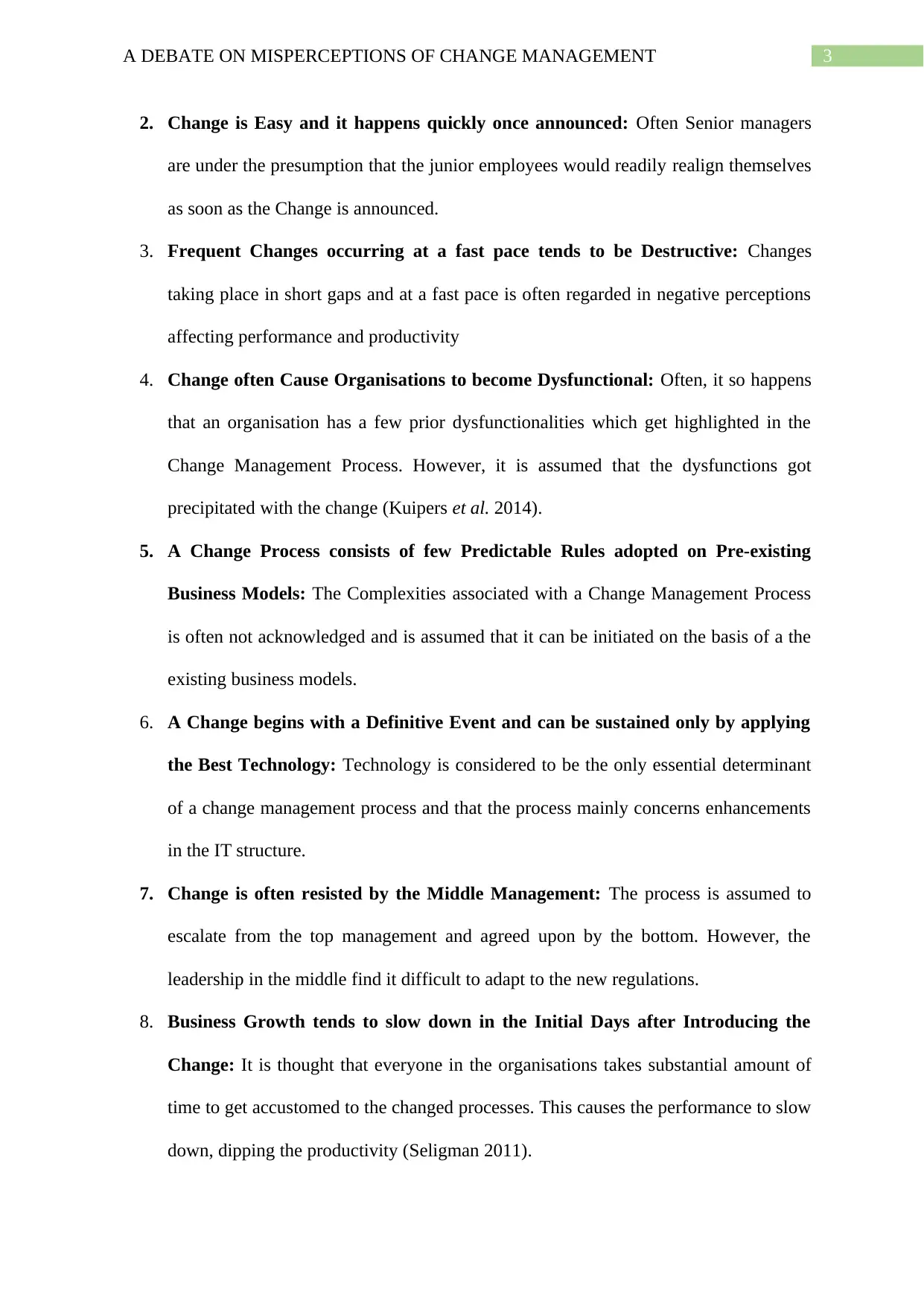
3A DEBATE ON MISPERCEPTIONS OF CHANGE MANAGEMENT
2. Change is Easy and it happens quickly once announced: Often Senior managers
are under the presumption that the junior employees would readily realign themselves
as soon as the Change is announced.
3. Frequent Changes occurring at a fast pace tends to be Destructive: Changes
taking place in short gaps and at a fast pace is often regarded in negative perceptions
affecting performance and productivity
4. Change often Cause Organisations to become Dysfunctional: Often, it so happens
that an organisation has a few prior dysfunctionalities which get highlighted in the
Change Management Process. However, it is assumed that the dysfunctions got
precipitated with the change (Kuipers et al. 2014).
5. A Change Process consists of few Predictable Rules adopted on Pre-existing
Business Models: The Complexities associated with a Change Management Process
is often not acknowledged and is assumed that it can be initiated on the basis of a the
existing business models.
6. A Change begins with a Definitive Event and can be sustained only by applying
the Best Technology: Technology is considered to be the only essential determinant
of a change management process and that the process mainly concerns enhancements
in the IT structure.
7. Change is often resisted by the Middle Management: The process is assumed to
escalate from the top management and agreed upon by the bottom. However, the
leadership in the middle find it difficult to adapt to the new regulations.
8. Business Growth tends to slow down in the Initial Days after Introducing the
Change: It is thought that everyone in the organisations takes substantial amount of
time to get accustomed to the changed processes. This causes the performance to slow
down, dipping the productivity (Seligman 2011).
2. Change is Easy and it happens quickly once announced: Often Senior managers
are under the presumption that the junior employees would readily realign themselves
as soon as the Change is announced.
3. Frequent Changes occurring at a fast pace tends to be Destructive: Changes
taking place in short gaps and at a fast pace is often regarded in negative perceptions
affecting performance and productivity
4. Change often Cause Organisations to become Dysfunctional: Often, it so happens
that an organisation has a few prior dysfunctionalities which get highlighted in the
Change Management Process. However, it is assumed that the dysfunctions got
precipitated with the change (Kuipers et al. 2014).
5. A Change Process consists of few Predictable Rules adopted on Pre-existing
Business Models: The Complexities associated with a Change Management Process
is often not acknowledged and is assumed that it can be initiated on the basis of a the
existing business models.
6. A Change begins with a Definitive Event and can be sustained only by applying
the Best Technology: Technology is considered to be the only essential determinant
of a change management process and that the process mainly concerns enhancements
in the IT structure.
7. Change is often resisted by the Middle Management: The process is assumed to
escalate from the top management and agreed upon by the bottom. However, the
leadership in the middle find it difficult to adapt to the new regulations.
8. Business Growth tends to slow down in the Initial Days after Introducing the
Change: It is thought that everyone in the organisations takes substantial amount of
time to get accustomed to the changed processes. This causes the performance to slow
down, dipping the productivity (Seligman 2011).
Secure Best Marks with AI Grader
Need help grading? Try our AI Grader for instant feedback on your assignments.

4A DEBATE ON MISPERCEPTIONS OF CHANGE MANAGEMENT
9. Understanding the Change is Essential before Committing to it: The lower
management is expected to have inadequate trust on the leadership when a change is
introduced. Therefore, unless sufficient trust exists, they will not develop proper
understanding of the changed regulations.
10. It is Normal to be Negatively Affected by the Change in order to be Accustomed
with it in due Time: It is assumed that people in the organisation becomes
pessimistic when a change in the existing structure is announced. They develop
negative assumptions regarding their existing benefits and this is where it is expected
that to adapt to such a large scale change, it takes considerable amount of time
(Kerzner and Kerzner 2017).
11. Those who do not participate in the Change are wrong: Not everyone would be
equally accepting the organisational change and therefore those who do not support it
are thought to be acting against the interest of the organisation.
12. If Communicated properly in the first attempt: It is assumed that if appropriate
training is provided on Team Leadership and Accountability, no more future follow
ups are required.
13. For achieving Business Outcomes, it is Not Mandatory to focus on the Emotional
Aspects: Emotions are considered to be a distraction in the path to achieve
organisational objectives and when the matter concerns change management, it is best
to avoid any emotional intervention.
14. The Focus of Change Management should be typically on Groups and not
Individuals: It is assumed that to acknowledge the change effectively, it must be
addressed across various groups in the organisation to make it happen quickly and
safely.
9. Understanding the Change is Essential before Committing to it: The lower
management is expected to have inadequate trust on the leadership when a change is
introduced. Therefore, unless sufficient trust exists, they will not develop proper
understanding of the changed regulations.
10. It is Normal to be Negatively Affected by the Change in order to be Accustomed
with it in due Time: It is assumed that people in the organisation becomes
pessimistic when a change in the existing structure is announced. They develop
negative assumptions regarding their existing benefits and this is where it is expected
that to adapt to such a large scale change, it takes considerable amount of time
(Kerzner and Kerzner 2017).
11. Those who do not participate in the Change are wrong: Not everyone would be
equally accepting the organisational change and therefore those who do not support it
are thought to be acting against the interest of the organisation.
12. If Communicated properly in the first attempt: It is assumed that if appropriate
training is provided on Team Leadership and Accountability, no more future follow
ups are required.
13. For achieving Business Outcomes, it is Not Mandatory to focus on the Emotional
Aspects: Emotions are considered to be a distraction in the path to achieve
organisational objectives and when the matter concerns change management, it is best
to avoid any emotional intervention.
14. The Focus of Change Management should be typically on Groups and not
Individuals: It is assumed that to acknowledge the change effectively, it must be
addressed across various groups in the organisation to make it happen quickly and
safely.

5A DEBATE ON MISPERCEPTIONS OF CHANGE MANAGEMENT
15. Consulting or Taking feedback from the Customers is Not Essential: A business
deliverable is mostly aimed at target consumers because that consists of one of the
main strategies to sustain the organisation. However, it is thought that the knowledge
of change may interfere with the loyalty of the existing customers. Therefore it is best
not to consult with them regarding change management.
Resistance to Organisational Changes
A change agent refers to an intermediary who sees through the entire process of
change management, from the time it gets initiated till it gets implemented and integrates
with the prior structure. However, the process is not always as smooth as it is theoretically
presumed. This is because for the change to be successfully implemented, the employees
need to have faith in it. Resisting a change is a natural phenomenon of human beings,
especially if they are well settled in the current setting (Andersson 2015). Therefore,
employees might feel the need to resist an organisational change owing to the uncertainty
associated in its practical implementation, they might be concerned about a certain personal
loss getting initiated as a result of the change or might assume that it would not be in the
business’s best interest.
Managing Resistance and Overcoming Misconceptions about Change
Management
By being positive role models to junior employees.
The new strategies should vouch to be a substantial improvement on the old strategies
that provides positive assurance about benefits to protect and support employees.
The managers must aim at implementing the strategies by clearly specifying the
expectations of advancement. It might be through incorporating a changed reward
system (Hernaus and Pološki Vokic 2014).
15. Consulting or Taking feedback from the Customers is Not Essential: A business
deliverable is mostly aimed at target consumers because that consists of one of the
main strategies to sustain the organisation. However, it is thought that the knowledge
of change may interfere with the loyalty of the existing customers. Therefore it is best
not to consult with them regarding change management.
Resistance to Organisational Changes
A change agent refers to an intermediary who sees through the entire process of
change management, from the time it gets initiated till it gets implemented and integrates
with the prior structure. However, the process is not always as smooth as it is theoretically
presumed. This is because for the change to be successfully implemented, the employees
need to have faith in it. Resisting a change is a natural phenomenon of human beings,
especially if they are well settled in the current setting (Andersson 2015). Therefore,
employees might feel the need to resist an organisational change owing to the uncertainty
associated in its practical implementation, they might be concerned about a certain personal
loss getting initiated as a result of the change or might assume that it would not be in the
business’s best interest.
Managing Resistance and Overcoming Misconceptions about Change
Management
By being positive role models to junior employees.
The new strategies should vouch to be a substantial improvement on the old strategies
that provides positive assurance about benefits to protect and support employees.
The managers must aim at implementing the strategies by clearly specifying the
expectations of advancement. It might be through incorporating a changed reward
system (Hernaus and Pološki Vokic 2014).
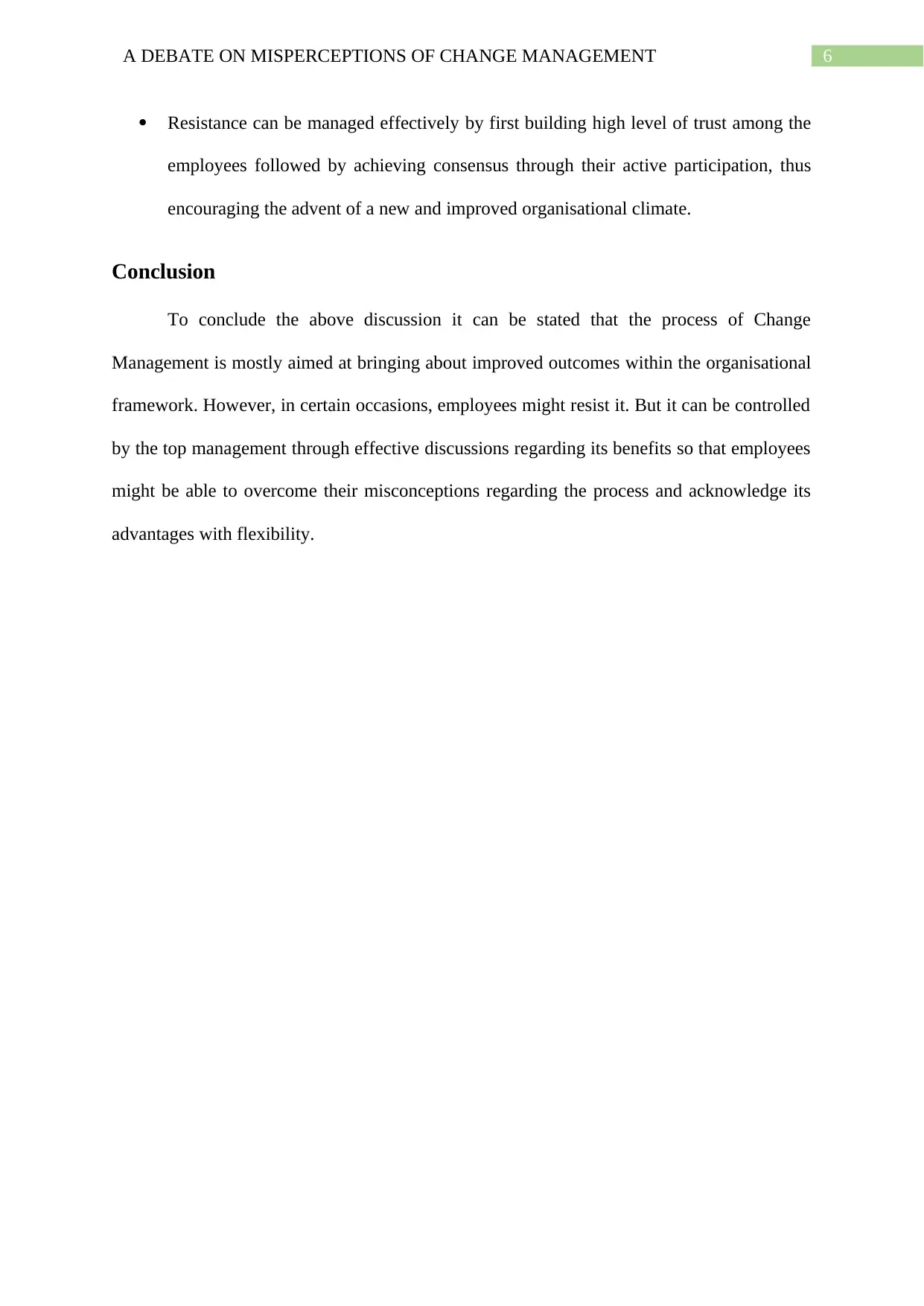
6A DEBATE ON MISPERCEPTIONS OF CHANGE MANAGEMENT
Resistance can be managed effectively by first building high level of trust among the
employees followed by achieving consensus through their active participation, thus
encouraging the advent of a new and improved organisational climate.
Conclusion
To conclude the above discussion it can be stated that the process of Change
Management is mostly aimed at bringing about improved outcomes within the organisational
framework. However, in certain occasions, employees might resist it. But it can be controlled
by the top management through effective discussions regarding its benefits so that employees
might be able to overcome their misconceptions regarding the process and acknowledge its
advantages with flexibility.
Resistance can be managed effectively by first building high level of trust among the
employees followed by achieving consensus through their active participation, thus
encouraging the advent of a new and improved organisational climate.
Conclusion
To conclude the above discussion it can be stated that the process of Change
Management is mostly aimed at bringing about improved outcomes within the organisational
framework. However, in certain occasions, employees might resist it. But it can be controlled
by the top management through effective discussions regarding its benefits so that employees
might be able to overcome their misconceptions regarding the process and acknowledge its
advantages with flexibility.
Paraphrase This Document
Need a fresh take? Get an instant paraphrase of this document with our AI Paraphraser

7A DEBATE ON MISPERCEPTIONS OF CHANGE MANAGEMENT
References
Andersson, G., 2015. Resisting organizational change. International Journal of Advanced
Corporate Learning (iJAC), 8(1), pp.48-51.
Doppelt, B., 2017. Leading change toward sustainability: A change-management guide for
business, government and civil society. Routledge.
Frankland, R., Mitchell, C.M., Ferguson, J.D., Sziklai, A.T., Verma, A.K., Popowski, J.E.
and Sturgeon, D.H., Applications in Internet Time LLC, 2013. Integrated change
management unit. U.S. Patent 8,484,111.
Hernaus, T. and Pološki Vokic, N., 2014. Work design for different generational cohorts:
Determining common and idiosyncratic job characteristics. Journal of Organizational Change
Management, 27(4), pp.615-641.
Kerzner, H. and Kerzner, H.R., 2017. Project management: a systems approach to planning,
scheduling, and controlling. John Wiley & Sons.
Kuipers, B.S., Higgs, M., Kickert, W., Tummers, L., Grandia, J. and Van der Voet, J., 2014.
The management of change in public organizations: A literature review. Public
administration, 92(1), pp.1-20.
Maimone, F. and Sinclair, M., 2014. Dancing in the dark: creativity, knowledge creation and
(emergent) organizational change. Journal of Organizational Change Management, 27(2),
pp.344-361.
Seligman, M., 2011. What you can change... and what you can't: the complete guide to
successful self-improvement. Hachette UK.
References
Andersson, G., 2015. Resisting organizational change. International Journal of Advanced
Corporate Learning (iJAC), 8(1), pp.48-51.
Doppelt, B., 2017. Leading change toward sustainability: A change-management guide for
business, government and civil society. Routledge.
Frankland, R., Mitchell, C.M., Ferguson, J.D., Sziklai, A.T., Verma, A.K., Popowski, J.E.
and Sturgeon, D.H., Applications in Internet Time LLC, 2013. Integrated change
management unit. U.S. Patent 8,484,111.
Hernaus, T. and Pološki Vokic, N., 2014. Work design for different generational cohorts:
Determining common and idiosyncratic job characteristics. Journal of Organizational Change
Management, 27(4), pp.615-641.
Kerzner, H. and Kerzner, H.R., 2017. Project management: a systems approach to planning,
scheduling, and controlling. John Wiley & Sons.
Kuipers, B.S., Higgs, M., Kickert, W., Tummers, L., Grandia, J. and Van der Voet, J., 2014.
The management of change in public organizations: A literature review. Public
administration, 92(1), pp.1-20.
Maimone, F. and Sinclair, M., 2014. Dancing in the dark: creativity, knowledge creation and
(emergent) organizational change. Journal of Organizational Change Management, 27(2),
pp.344-361.
Seligman, M., 2011. What you can change... and what you can't: the complete guide to
successful self-improvement. Hachette UK.
1 out of 8
Related Documents
Your All-in-One AI-Powered Toolkit for Academic Success.
+13062052269
info@desklib.com
Available 24*7 on WhatsApp / Email
![[object Object]](/_next/static/media/star-bottom.7253800d.svg)
Unlock your academic potential
© 2024 | Zucol Services PVT LTD | All rights reserved.
